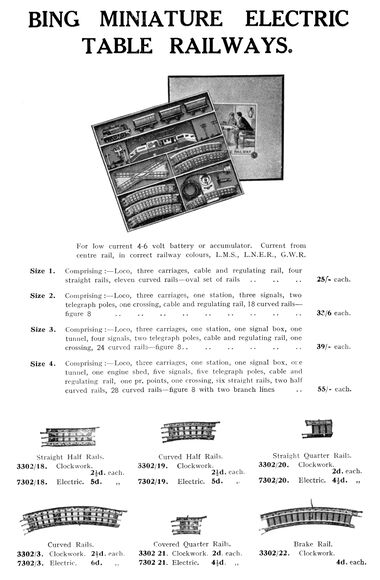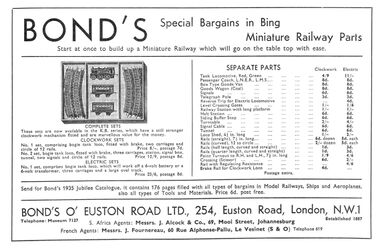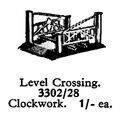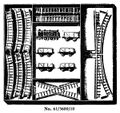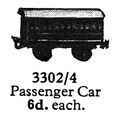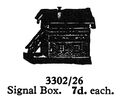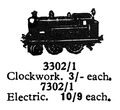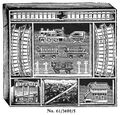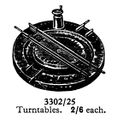Category:Bing Table Railway
| Toy Brands and Manufacturers |
|---|
Bing Table Railway |
| 1922 - 1930s |
Bing Table Railway sets, clockwork, sets 1-10 (Bing catalogue) [image info]
Bing miniature table railway sets, electric, 1-4 (Bing catalogue) [image info]
Bonds of Euston Road, sale of Bing Table Railway equipment in November 1935. This was presumably a clearance of old stock, rendered obsolete by the launch of Trix Express in spring 1935 [image info]
A range of Bing Table Railway pieces in the museum's Collectors' Market (November 2015) [image info]
The Bing Table Railway system ("BTR") launched in 1922 was the first proper commercial 00/H0-gauge system, and as such was the ancestor of all modern approximately-16mm-gauge model railways.
While the smallest existing standard-size railway format (gauge 0) still required a space equivalent to the floor of a decent-sized room, this new half-sized system could - amazingly! - fit a complete layout onto the top of a domestic dining table.
Origins
Although there had been previous experimental attempts to try to squeeze clockwork or electric motors into the tiny space of a chassis that could run on approximately half-size track, there wasn't yet a proper commercial system that aimed to achieve the reliability and safety needed for a full-scale product launch.
The impetus for the new system came from W.J. Bassett-Lowke and Bassett-Lowke Limited. After talks with Bing Werke, WJ persuaded Bing that if they produced a half-sized model railway system, then Bassett-Lowke would be happy to sell it into the UK market.
The specifications of the new "Table Railway" format were thrashed out between BL's and Bing's people (notably Henry Greenly in the UK, and Oswald Fischer in Germany) , and the new rail width, half that of the existing gauge 0 track, became "double-0" or "00-gauge" format, with Greenly specifying the scale and making sure that the "look" of the final product would be acceptable to British buyers.
Once the First World War (1914-1918) was over, research on the new half-scale format continued, with the final system being proudly presented in 1922. By 1926 the range had expanded to ten clockwork sets and four electric.
Difficulties
The Bing Tabletop Railway system didn't last very long, with further development halting after about three years. To modern eyes, the BTR locos and rolling stock seem very crude and clunky (although they do arguably have an odd "boxy" period charm), but the sets were also very cheap compared to larger and more conventional model railways. Two more important issues were that Bassett-Lowke were now trying to sell an obviously German model railway system in the UK only a few years after WW1, when memories of the conflict were still very raw (with B-L keen to avoid being accused of promoting German-made goods), and ... of course ... the German economic problems that were reflected in Bing Werke's's worsening financial problems through the late 1920s, with several key staff "leaving the sinking ship" years before the company's final official demise in 1932.
00 and H0 scales
Since the scale of gauge 0 model railways was "7mm to the foot", it was logical for the Bing system, with half-size track, to be scaled at 3.5mm to the foot. However, the system was already pushing the boundaries of what was technically achievable, and the Bing system's "chunky" wheels meant that it would be difficult or impossible to reproduce the external wheelwork of some British locos at 3.5mm scale. Greenly accordingly specified that the superstructure of the locomotives (and therefore also the carriages, and trackside accessories) be constructed to the larger scale of 4mm to the foot ... although with the Bing system, the fact that the pieces weren't obviously based on a particular real-world locomotive design made the system's "official" scale regarding anything but the track size slightly moot. this "four-millimetre" scale became known as 00 gauge.
Four millimetre scale was then adopted by Trix Twin Railway and Hornby Dublo, and once its use had reached critical mass in the UK it became the country's standard. Elsewhere, manufacturers used later, more accurate "scale" wheels that allowed more proportional 3.5mm to the foot modelling, and this became known as H0 gauge, for "Half 0 gauge".
Successors
Karl Bub's Table Railway
Fellow German toymaker Karl Bub then took over production of the Table Railway system, but since they were sensitive to many of the same issues that had affected Bing Werke with regard to the difficulty of exporting to foreign markets after WW1, this was primarily for local consumption.
Not only were there trade tariffs and threats of possible further trade restrictions to support domestic manufacturers, there was also the problem of German inflation making the products more expensive abroad, and uncertainty over whether whether future inflation or tariffs might make the situation even worse - it was difficult for foreign retailers to commit to promoting a brand if they couldn't be guaranteed further supplies at a known price, if their customers were unenthusiastic about "buying German", and if there were new and interesting local companies springing up to sell similar products.
Trix Twin Railway, "TTR"
In the 1930s, Bassett-Lowke tried again and resurrected the idea with a new and improved version of the system. Stefan Bing had left Bing Werke and had taken with him some key personnel including Siegfried Kahn to start a new company that initially made "Trix" metal construction sets. W.J. Bassett-Lowke contacted Stefan and Siegfried and with the help once again of Henry Greenly, produced a new 00-gauge system, Trix Express (and then, once Stefan and Siegfried had moved to Trix Limited in the UK, Trix Twin Railway (TTR).
Bassett-Lowke considered TTR to be the successor to the Bing Table Railway, and referred to it in their literature as the "Twin Table Railway", a reference to the earlier Bing system.
Unfortunately, the legacy of BTR on TTR was that the Trix trains inherited some of the clunky design and crude-looking wheels from the old Bing system, and this made it increasingly difficult for their train sets to compete with the new Hornby Dublo sets that were launched in 1937, or with the Triang sets that appeared after World War Two, both of which had more accurately scaled wheels and bodywork.
Branding and distribution
Although Bassett-Lowke's input to BTR had been significant, the Bing Table Railway was presented very much as a Bing product, without Bassett-Lowke having exclusivity - if B-L promoted the system to potential customers, those customers could then buy their train set at a local shop rather than through B-L. It's been said that by initiating the Bing Table Railway project, W.J. could have reasonably claimed to be "the father of 00-gauge", if it wasn't for the fact that his name and his company's name were absent from the BTR product.
These were both issues that W.J. tried to address with the later 1930s "Trix Twin Railway" system, where B-L negotiated a royalty and a "designed by Bassett-Lowke" sticker on items with design work by Henry Greenly, and made sure that their own material stressed that his was a B-L product, to be bought from B-L.
In the museum
The museum has a display cabinet dedicated to the Bing and Bub table railway sets and accessories, in Arch Three. However, as of mid-2014, the contents of this cabinet don't yet have an online listing.
External links
- "A HISTORY OF 00 GAUGE - Part I: The Years of Experimentation 1920-39", by Stephen Siddle (doubleogauge.com)
- Bing table railway set, Victoria and Albert Museum (collections.vam.ac.uk)
- Bing Table Railway, Newcastle Arts Centre (newcastle-arts-centre.co.uk)
Subcategories
This category has the following 3 subcategories, out of 3 total.
Pages in category ‘Bing Table Railway’
The following 18 pages are in this category, out of 18 total.
B
G
L
- Level Crossing, three-rail (Bing Table Railway)
- LMS 2-4-0 electric tank locomotive (Bing Table Railway)
- LNER 504 2-4-0 clockwork locomotive with tender (Bing Table Railway)
- LNER 504 2-4-0 clockwork tank locomotive (Bing Table Railway)
- LNER goods wagon (Bing Table Railway)
- LNER teak-effect coaches (Bing Table Railway)
- LNWR 2-4-0 clockwork tank locomotive (Bing Table Railway)
M
T
Media in category ‘Bing Table Railway’
The following 23 files are in this category, out of 23 total.
- Bing Miniature Clockwork Table Railways (BTC).jpg 1,426 × 2,203; 672 KB
- Bing Miniature Electric Table Railways (BTC).jpg 2,836 × 4,327; 920 KB
- Bing Miniature Railway, Bond's (MM 1935-11).jpg 1,138 × 748; 161 KB
- Bing Miniature Railway, lineart (MM 1935-11).jpg 1,176 × 834; 331 KB
- Bing Table Railway clockwork set, 1928 UK catalogue image.jpg 1,800 × 435; 214 KB
- Bing Table Railway electric set, 1928 UK catalogue image.jpg 1,800 × 319; 193 KB
- Bing Table Railway pieces (Collectors Market, 2015-11).jpg 2,000 × 1,124; 1.07 MB
- Bing Table Railway set 61-7300-3 (BingCatEn 1928).jpg 765 × 1,200; 319 KB
- Level Crossing, Bing Table Railway 3302-28 (BingCatEn 1928).jpg 427 × 411; 73 KB
- Lilliput Express accessories for Bing 500-504 (BingCatFr 1925).jpg 1,200 × 648; 111 KB
- Lilliput Express logo 1925.jpg 989 × 190; 40 KB
- Lilliput Express set 500, Bing (BingCatFr 1925).jpg 1,186 × 778; 220 KB
- Lilliput Express set 503, Bing (BingCatFr 1925).jpg 1,208 × 1,480; 536 KB
- Lilliput Express set 504, Bing (BingCatFr 1925).jpg 1,200 × 655; 191 KB
- LMS clockwork freight train set, Bing Table Railway 61-3600-10 (BingCatEn 1928).jpg 1,200 × 1,134; 380 KB
- Open Goods Truck, Bing Table Railway 3302-24 (BingCatEn 1928).jpg 406 × 315; 32 KB
- Passenger Car, Bing Table Railway 3302-4 (BingCatEn 1928).jpg 333 × 325; 35 KB
- Rolling Stock and Accessories, Bing Table Railway (BingCatEn 1928).jpg 1,200 × 726; 365 KB
- Signal Box, Bing Table Railway 3302-26 (BingCatEn 1928).jpg 465 × 389; 64 KB
- Tender clockwork train set, Bing Table Railway 61-3600-5 (BingCatEn 1928).jpg 1,200 × 1,151; 506 KB
- Turntable, Bing Table Railway 3302-25 (BingCatEn 1928).jpg 545 × 557; 78 KB


